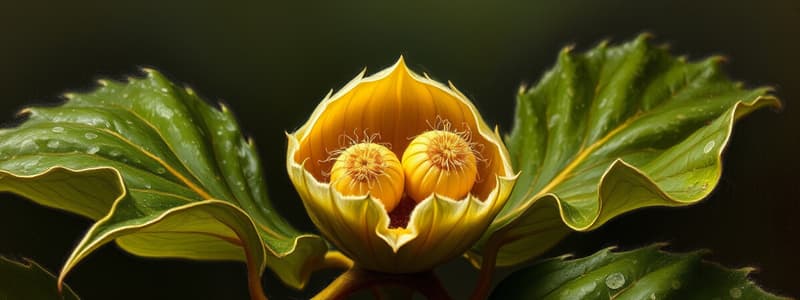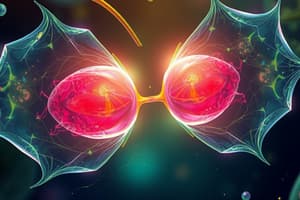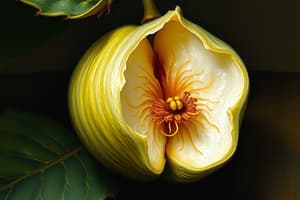Podcast
Questions and Answers
Seedless fruit can be produced through genetic selection of plants that produce a significant amount of seeds.
Seedless fruit can be produced through genetic selection of plants that produce a significant amount of seeds.
False (B)
One method of producing seedless fruit involves asexual propagation of plants.
One method of producing seedless fruit involves asexual propagation of plants.
True (A)
All varieties of seedless fruit result from cross-pollination techniques.
All varieties of seedless fruit result from cross-pollination techniques.
False (B)
Watermelons are an example of seedless fruit produced by genetic selection.
Watermelons are an example of seedless fruit produced by genetic selection.
The production of seedless fruit is limited to the use of traditional farming techniques.
The production of seedless fruit is limited to the use of traditional farming techniques.
Auxins are used to induce fruiting without fertilization in seedless fruit production.
Auxins are used to induce fruiting without fertilization in seedless fruit production.
Water-dispersed seeds lack pockets of air, causing them to sink.
Water-dispersed seeds lack pockets of air, causing them to sink.
Dormancy allows seeds to germinate immediately when conditions are suitable.
Dormancy allows seeds to germinate immediately when conditions are suitable.
Animal dispersal involves seeds passing through an animal's digestive system before germination.
Animal dispersal involves seeds passing through an animal's digestive system before germination.
Self-dispersal occurs when seeds are actively thrown away from the parent plant.
Self-dispersal occurs when seeds are actively thrown away from the parent plant.
Study Notes
Double Fertilisation and Seed Formation
- After fertilisation, the ovule swells and its wall toughens to form the seed coat (testa).
- The zygote develops into the seed embryo, while a triploid endosperm nucleus quickly divides to create food storage tissue.
- The integuments of the ovule thicken to form the testa, leading to the complete seed formation.
- Once fully formed, the seed dries out and enters a dormant state.
Seed Structure and Types
- Embryo: Develops into the new plant.
- Testa: The hard outer seed coat for protection pre-germination.
- Radicle: Emerges first as the root of the new plant.
- Plumule: Develops into the shoot after the radicle.
- Cotyledons: Seed leaves that store food for early-stage germination; can be one (monocot) or two (dicot).
- In monocots (e.g., maize, wheat), the food is stored in the endosperm (endospermic seeds).
- In dicots (e.g., broad bean), food is stored in cotyledons (non-endospermic seeds).
Fruit Formation
- Fruits protect seeds and facilitate their dispersal.
- Seedless fruits, like watermelons, arise either through genetic selection or hormonal induction, bypassing fertilisation.
Seed Dispersal Mechanisms
- Animal Dispersal: Seeds pass through animals’ digestive systems; digestion may be necessary for germination (e.g., tomato, apple).
- Wind Dispersal: Seeds need lightweight and large surface areas (e.g., sycamore and dandelion parachutes).
- Self-dispersal: Pea pods curl and split when dry, releasing seeds (e.g., Gorse).
- Water-dispersal: Seeds feature air pockets for buoyancy, enabling long-distance dispersal (e.g., yellow water lily).
Dormancy
- Period of reduced growth/metabolism when conditions are suitable for germination.
- Advantages:
- Avoids damage from adverse conditions.
- Allows seeds time to disperse and reduce competition.
- Allows embryos time to mature before conditions improve.
Breaking Dormancy
- Waterproof Testa in some plants inhibits water intake, maintaining dormancy.
- Runners with plantlets can provide nourishment, increasing establishment chances.
- Once established, the runner can wither, making the new plant independent.
Artificial Propagation Methods
- Cuttings: Shoots are removed and placed in soil or water to root (e.g., geranium).
- Layering: A cut shoot is set into the soil to form a new plant; roots develop after about one year (e.g., blackberry).
- Grafting: A scion (shoot twig) is attached to rootstock, allowing cambium layers to unite (e.g., apples).
- Micropropagation: Individual cells can be cultured to grow new plants, useful in commercial crops and houseplants (e.g., bananas).
Mandatory Practical Investigations
- Setup four test tubes with cotton wool and seeds to study the effect of water, oxygen, and temperature on germination:
- Test Tube A: Keep dry (no water).
- Test Tube B: Moistened cotton wool placed in the refrigerator (incorrect temperature).
- Test Tube C: Covered seeds with boiled water.
Studying That Suits You
Use AI to generate personalized quizzes and flashcards to suit your learning preferences.
Related Documents
Description
Explore the fascinating process of double fertilisation and seed formation in plants. This quiz covers details on seed structure, including the roles of embryos, testa, radicle, and cotyledons. Test your understanding of how these components contribute to fruit formation and plant development.




